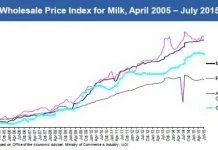Source: bangalore.citizenmatters.in
Half litre Nandini milk and curd packets don’t carry the words ‘Use by’ on the packaged date stamping. As a result, you might be buying old milk, which might curdle the moment you keep it for heating. What’s wrong here?
Milk has benign associations – of innocence, goodness and wholesomeness, unlike other (invigorating) drinks. But Nandini milk, marketed by the Karnataka Milk Federation (KMF which boasts of being one of the largest in south India) is calling those images of wholesomeness into question with tactics that flout statutory guidelines.
In 2004, I wrote about how milk pouches were being sold with “tomorrow’s date” stamped on them, without indicating whether it was the date of packing or date of expiry. Which meant customers buying pouches that were a day old, would be misled into believing that it was “today’s milk”. This amounted to cheating, and flouting the statutory rule about stamping the date of packing, especially for a commodity as perishable as milk.
Over three decades ago, we at the Consumer Guidance Society of India (CGSI – India’s oldest consumer protection group) at Mumbai had lobbied hard to make the stamping of expiry dates mandatory for perishable packaged food items. On 25 May, 2007, I again wrote about this malpractice in my column on consumer rights, about “tomorrow’s milk” being sold today (you could buy milk on May 24th, with the stamp saying May 25th, without indicating whether it was date of packing or expiry date). Leftover pouches could thus easily be sold off as “fresh” supply. My report brought a response from KMF saying that they were “taking appropriate action.”
Now, 11 years after my first expose, Bengalureans are still able to buy milk on July 23 marked “July 24.” Citizen Matters and I did some research, and found that some pouches (especially the one litre packs) did say “Use by” but others (especially the half litre pouches) only have a date marked, without specifying whether it is date of packing or date of expiry. This amounts to cheating tens of thousands of consumers, and flouting the law.
Phone calls to the KMF numbers brought no response. At Malleshwaram and Jayanagar, I saw on August 31, half litre packs with just dates. It is not even a question of lack of space to print “use by” because some pouches do indeed have that phrase, so what’s going on?

Lack of quality galores
There have also been, predictably, reports of milk curdling frequently in the last few days, even when used on the date stamped on the packs. Customers cannot return faulty or curdled packets to the sales outlets, under the rules. When asked, the vendors refuse to take responsibility and put the blame on customers, with ready statements like “you may not have washed your vessel well” or “something might have falled into the vessel”.
Reports of Nandini curds also going bad are also coming in. Especially during the Vara Mahalakshmi festival last week, people in many areas were left with curdled milk packaged as ‘curd’, which tasted bitter, which probably happens when there is excess of sodium bicarbonate in the milk which stops the fermentation process, and stops the milk from being converted fully to curd.
Did KMF learn nothing from the media exposure condemning its malpractice, in 2004 and 2007? Did their PR response (we are looking into it… etc) mean anything? For a while, “tomorrow’s milk” was indeed stopped being sold today, but we seem to be back again to the old lackadaisicalness again. True, the supply of milk might have been increased due to the extra subsidy given to milk suppliers. But there has to be a good way to use the milk, instead of finding backdoors to push this to innocent customers.
I had also written about how the price of Rs 29 for a litre is sometimes misleading – if I am given two half litre packs, I am charged Rs 30, not 29. “Our supply is mostly of half litre packs, which cost Rs 15, we don’t get enough one litre pouches delivered,” explains one Nandini outlet manager. But the larger question, of why the “use by” phrase is dropped from most pouches, remains unexplained. Just one more instance of a government undertaking taking the public for a ride with impunity?


































